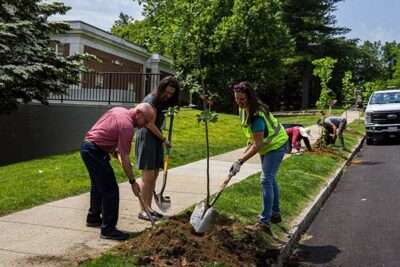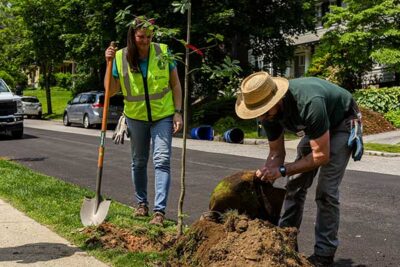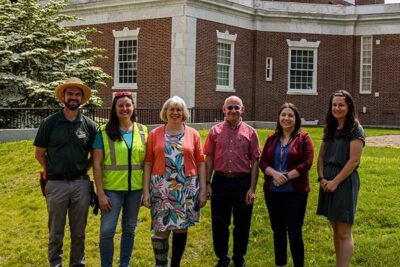By Liz Nye, New England Botanic Garden
June 2025

American Antiquarian Society President Scott Casper, Worcester City Councilor Jenny Pacillo and New England Botanic Garden CEO Grace Elton plant a tree along Regent Street. Photo by Megan Stouffer
On a recent sunny day in June, a group of Garden staff made their way to Regent Street in Worcester with eight young trees in tow. The trees, gifts from the Garden and donor Dennis Gorman, were headed to a planting site on a section of street that runs alongside the American Antiquarian Society’s iconic Antiquarian Hall. Earlier this spring, several mature trees in this area were lost to black knot fungus (Apiosporina morbosa).
“When we learned about this loss, we saw an opportunity to collaborate with our partners at the Antiquarian Society and the City of Worcester,” said Garden CEO Grace Elton. “It’s extremely important that we contribute not only to the growth of the city’s urban tree canopy, but also to a biodiverse urban forest.”
Urban forests—all the trees in a city, including those found in parks, along streets, and in private yards and businesses—support healthy cities in a variety of ways. Trees clean the air, cool built landscapes, mitigate stormwater, and provide habitat for wildlife. That’s not to mention the countless mental and emotional benefits trees bring to city residents. But like all forest ecosystems, urban forests are only as strong as they are diverse. This fact was not historically well known. It was once extremely common for city planners, valuing symmetry, to line streets with trees of a single species only. Over the years, cities learned the hard way how vulnerable these urban monocultures can be. Worcester lost a staggering 30,000 trees following an infestation of Asian longhorned beetle (Anoplophora glabripennis) in 2008. At the time, the city’s urban forest was comprised largely of maples (Acer spp.), a favorite food source of the non-native beetle.
“Different species respond to pressures in their environment differently,” says Steve Conaway, the Garden’s director of horticulture. “Where one tree may be susceptible to a certain pest, disease, extreme weather condition, or shift in weather patterns, another may be resistant.”

New England Botanic Garden CEO Grace Elton and Director of Horticulture Steve Conaway. Photo by Megan Stouffer
Black knot fungus, for example, the pathogen responsible for the previous tree failures on Regent Street, attacks trees in the genus Prunus such as ornamental, edible, and native plums and cherries. The fungus forms swollen cankers that girdle tree branches, cutting off the flow of water and nutrients. While the flowering cherry trees that once lined Regent Street succumbed to black knot fungus, the new trees selected by the Garden—hackberry (Celtis occidentalis), hardy rubber tree (Eucommia ulmoides), tupelo (Nyssa sylvatica), American hornbeam (Carpinus caroliniana), honey locust (Gleditsia triacanthos var. inermis), American basswood (Tillia americana), and tulip poplar (Liriodendron tulipifera)—will not. That isn’t to say these trees don’t have their own vulnerabilities, but diversity builds resilience and provides insurance against calamity. This lesson is essential in today’s approach to urban forestry, especially as cities and communities strive to address the complex challenges of the climate crisis.

(From left to Right) Steve Conaway, Director of Horticulture at New England Botanic Garden; Grace Elton, CEO of New England Botanic Garden; Lynn Swain, Vice President for Advancement at the American Antiquarian Society; Scott Casper, President of the American Antiquarian Society; Kristen Balash, Vice President for Finance and Administration at the American Antiquarian Society; and Jenny Pacillo, Worcester City Council, District 1. Photo by Megan Stouffer
Tree diversity in Worcester has improved over the last two decades. The City’s Urban Forest Master Plan reports that in 2022, 165 different species were inventoried, up from 98 in 2005. Maple trees still represent 38% of the urban tree canopy, exceeding industry recommendations that no genera make up more than 20%. Recently adopted, the Urban Forest Master Plan is the first of its kind for Worcester. It considers important issues of biodiversity, climate change, and tree equity, and charts a management course for the future. There is no doubt still a long way to go when it comes to growing and protecting Worcester’s urban forest—and to bringing the benefits of trees to neighborhoods that need them most—but collaborations between local government, organizations, community groups, and individuals can make a difference.
At the tree planting on Regent Street, Worcester City Councilor Jenny Pacillo and staff from the American Antiquarian Society met up with the Garden team to offer their support and their thanks. The new trees will be managed by Worcester’s Department of Public Works and Parks and enjoyed by countless American Antiquarian Society visitors, their fellows, and staff.
“Trees are vital to the quality of life in Worcester, especially in the summer when they provide shade and cool spots for residents and visitors,” said Antiquarian Society President Scott Casper. “We are grateful to New England Botanic Garden and the City of Worcester for partnering to plant new trees in the heart of our campus.”
“It’s wonderful,” said Councilor Pacillo, “when neighbors see the value of street trees and want to share in this work.”
Liz Nye is the Public Relations Manager at New England Botanic Garden. She holds a master’s degree in science writing from Johns Hopkins University and enjoys learning about and writing about all things plants.
